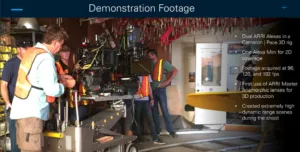DoP Bill Bennett and RealD Sr. Scientist Tony Davis gave a presentation to detail some of the experience the two have gained in capturing cinematic content at high frame rates and then using a synthetic shutter technique developed by Davis, and called TrueMotion, to create various pieces of content.
We first reported on this technology back in November 2016 (RealD Develops Synthetic Shutter Solution for HFR). Davis suggests that by acquiring content at a higher frame rate, signal processing can be used to create all kinds of new “looks” along with conventional 24fps, 180-degree shutter angle movies. The above article describes the theory that allows Davis to create a wide variety of shutter angles with non-square shapes and different frequencies. The whole idea is to reduce judder and motion blur – which can be applied on a frame-by-frame basis, if desired.
The technique was used by Ang Lee to create derivative versions of his “Billy Lynn’s Long Halftime Walk” movie. The film was shot at 120 fps with a 360º shutter, but was shown theatrically at 24 or 60 fps and with a conventional 180º shutter. TrueMotion was used to develop these derivatives. Lee could have created a 24 fps version that looked as though it was shot at 24fps/180º – complete with judder and motion blur, but he chose to apply a different synthetic shutter that more closely replicated the “emotional look and feel” of the 120fps version. That’s the benefit of this new approach.
At HPA, Davis explained that capturing at 120fps is convenient as it is a even multiple of 24, 25, 30 and 60 fps making the image processing a bit simpler. This is handy as derivative versions can be easily created for different platforms running at those frame rates.
Acquiring at high frame rate is great as no motion is lost in capture and motion softness is a post production decision. Of course, the high frame rate means a lot more data is captured, but Davis says this can be partially mitigated with higher compression ratios with compression artifacts reduced during the frame blend.
Davis then provided some details on the Billy Lynn project and showed some additional demonstration footage shot with Bill Bennett, ASC, who noted that high contrast images tend to judder as they move across the screen. TrueMotion allows for windowing of parts of the image and applying different synthetic shutters in these windows to create frames with mixed shutter rates.
This technique appears to offer some nice benefits, but clearly more testing is being done as no new films using the techniques were announced. – CC

